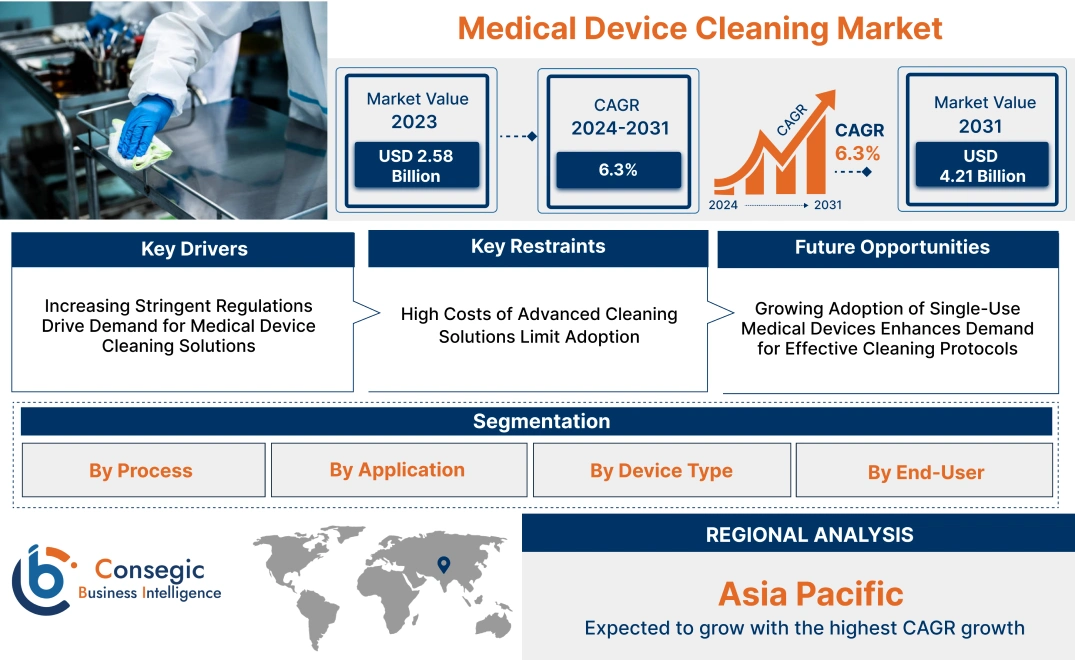- Summary
- Table Of Content
- Methodology
Medical Device Cleaning Market Size:
Medical Device Cleaning Market size is estimated to reach over USD 4.21 Billion by 2031 from a value of USD 2.58 Billion in 2023 and is projected to grow by USD 2.70 Billion in 2024, growing at a CAGR of 6.3% from 2024 to 2031.
Medical Device Cleaning Market Scope & Overview:
Medical device cleaning involves removing contaminants such as biological debris, chemical residues, and microorganisms from medical instruments and devices. This process is crucial for ensuring patient safety, preventing healthcare-associated infections, and maintaining the integrity of sensitive medical equipment. Cleaning methods can include manual cleaning, ultrasonic cleaning, automated washers, and specialized chemical disinfectants. Proper cleaning enhances device longevity, supports effective sterilization, and complies with regulatory standards. Applications span surgical instruments, endoscopes, dental devices, and diagnostic equipment, making it vital across hospitals, clinics, and ambulatory surgical centers.
Medical Device Cleaning Market Dynamics - (DRO) :
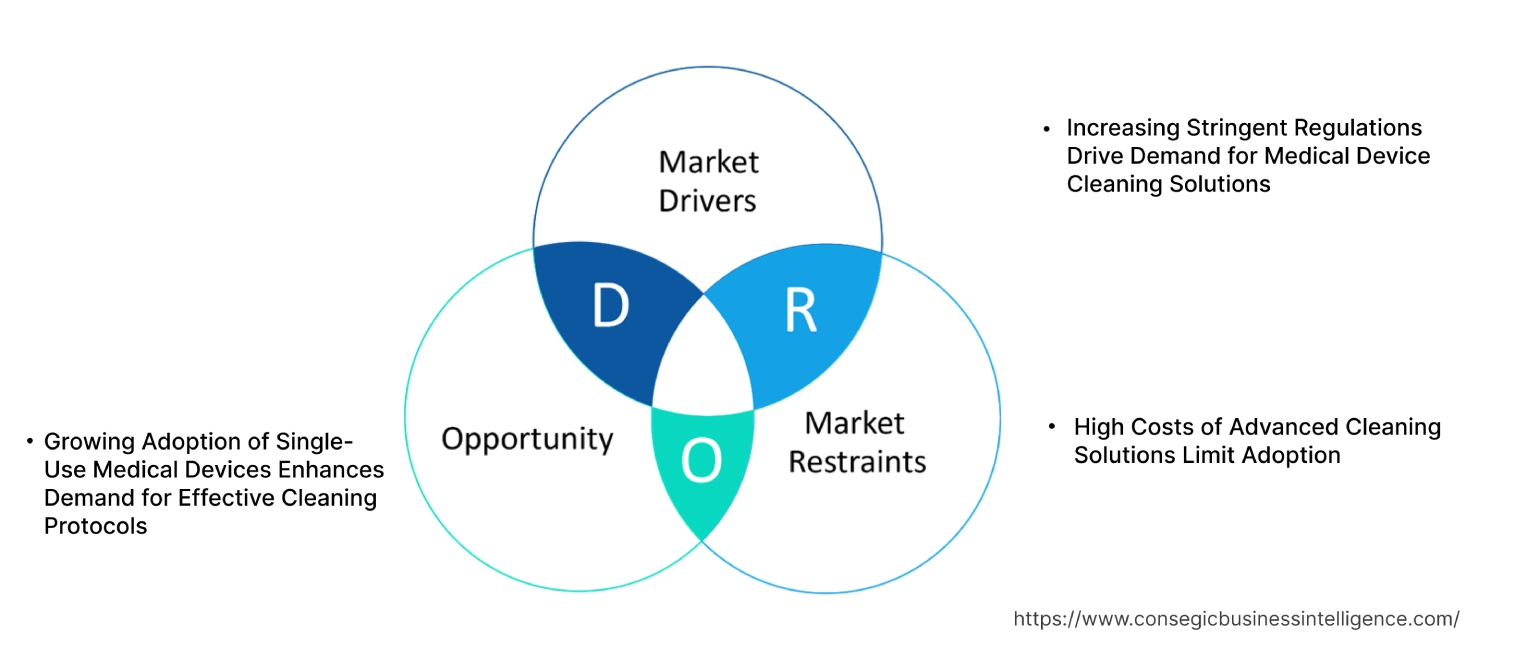
Key Drivers:
Increasing Stringent Regulations Drive Demand for Medical Device Cleaning Solutions
The rising enforcement of stringent regulations regarding infection control and patient safety is driving the medical device cleaning demand for solutions. Regulatory bodies such as the U.S. Food and Drug Administration (FDA), the European Medicines Agency (EMA), and others mandate strict hygiene protocols for reusable medical devices, including surgical instruments, endoscopes, and diagnostic equipment. Non-compliance can lead to severe penalties and increased risk of infections, prompting healthcare facilities to invest in advanced cleaning and sterilization products. The implementation of these regulations emphasizes the need for effective and thorough cleaning procedures to ensure patient safety, leading to a greater adoption of specialized cleaning solutions in the medical device industry.
Key Restraints :
High Costs of Advanced Cleaning Solutions Limit Adoption
The high costs associated with advanced medical device cleaning solutions act as a significant restraint for medical device cleaning market growth. Specialized cleaning agents, automated washer-disinfectors, and ultrasonic cleaning systems are essential for thorough disinfection and compliance with regulatory standards. However, their high initial investment and maintenance costs make it challenging for small and mid-sized healthcare facilities to adopt these solutions. Additionally, the need for trained personnel to operate advanced equipment adds to the overall expense, further limiting widespread adoption, particularly in developing regions with limited budgets.
Future Opportunities :
Growing Adoption of Single-Use Medical Devices Enhances Demand for Effective Cleaning Protocols
The increasing shift towards single-use and minimally invasive medical devices presents a key medical device cleaning market opportunity. As healthcare facilities focus on reducing infection risks and ensuring patient safety, the demand for effective cleaning protocols for reusable components of single-use devices is on the rise. Single-use devices often include reusable parts like handles or endoscope connectors that require thorough cleaning and disinfection. This medical device cleaning trend drives the need for specialized cleaning solutions tailored for these components, creating opportunities for market players to develop innovative products that meet evolving industry standards.
Medical Device Cleaning Market Segmental Analysis :
By Process:
Based on process, the market is segmented into Disinfection, Automatic Cleaning, Manual Cleaning, and Presoaking/Precleaning.
The disinfection segment accounted for the largest revenue share in 2023.
- The disinfection process is integral to medical device cleaning, targeting a broad spectrum of microorganisms.
- High-level disinfection, used for devices contacting sterile body parts, eliminates all forms of microbial life except high concentrations of bacterial spores.
- This segment is driven by stringent infection control policies, especially in surgical and critical care units.
- Intermediate-level disinfection is favored in outpatient settings for devices like respiratory therapy equipment, targeting resistant mycobacteria and various pathogens.
- Low-level disinfection, typically used for non-critical devices, is gaining traction in home healthcare and rehabilitation centers due to cost-effectiveness and ease of application.
- Thus, the segmental trends analysis shows that the rise in hospital-acquired infections (HAIs) has amplified demand for effective disinfection protocols across all healthcare industries, boosting the medical device cleaning market demand.
Automatic Cleaning segment is anticipated to register the fastest CAGR during the forecast period.
-
- Automated solutions like washer disinfectors and ultrasonic cleaners dominate the market due to their high efficiency in handling large volumes of instruments.
- Hospitals with high patient throughput increasingly rely on automated systems to minimize the risk of human error, enhance compliance with infection control standards, and optimize workflow.
- Ultrasonic cleaning, in particular, has seen widespread adoption for its ability to effectively clean devices with complex geometries, reducing the need for manual scrubbing and thereby preventing device damage.
- Hence, the analysis of segmental trends depicts that ultrasonic cleaners improve efficiency, reduce human error, and support high infection control boosting the medical device cleaning market trends.
By Application:
Based on components, the market is segmented into Surgical Instruments, Endoscopes, Ultrasound Probes, Dental Instruments, and Other Instruments:
Surgical Instruments segment accounted for the largest revenue share of the overall Medical device cleaning market share in 2023.
- The surgical instruments segment is the largest application area due to the high frequency of use in operating rooms.
- Instruments like scalpels, forceps, and clamps require meticulous cleaning to prevent post-operative infections and ensure patient safety.
- The adoption of specialized cleaning agents that effectively remove blood and tissue residues without damaging the instrument surfaces is driving growth in this segment.
- Furthermore, increasing surgical procedures globally are boosting the demand for robust cleaning solutions tailored for complex and delicate instruments.
- Therefore, the analysis of segmental trends depicts that the patient's safety certainty and adoption of specialized cleaning is boosting the medical device cleaning market trends.
The endoscopes segment is anticipated to register the fastest CAGR during the forecast period.
- Endoscopes are among the most challenging medical devices to clean due to their narrow lumens and intricate designs.
- The segment is seeing significant advancements, including the use of automated endoscope preprocessors (AERs), which provide consistent, high-level disinfection.
- The surge in minimally invasive procedures, which rely heavily on reusable endoscopes, has heightened the focus on improving cleaning protocols and reducing cross-contamination risks.
- Additionally, the implementation of guidelines by regulatory bodies like the CDC for endoscope reprocessing is further driving segment growth.
- Hence, the market trend analysis shows that high-level disinfection and cleaning protocols are creating fresh opportunities for the Medical device cleaning market trend.
By Device Type:
Based on components, the market is segmented into Non-Critical Devices, Semi-Critical Devices, and Critical Devices.
The non-critical segment accounted for the largest revenue share of 52.62% of the total medical device cleaning market share in 2023.
- Non-critical devices, that contact intact skin (e.g., blood pressure cuffs, stethoscopes), require routine low-level disinfection.
- The segment's growth is driven by increasing emphasis on hygiene protocols in outpatient care and home healthcare environments, where these devices are frequently reused.
- Innovations in antimicrobial wipes and sprays tailored for non-critical surfaces are gaining popularity for their ease of use and efficiency.
- Therefore, market trend analysis shows a rise in low-level disinfection solutions, like antimicrobial wipes, for non-critical devices due to heightened hygiene protocols is boosting the market.
The semi-critical devices segment is anticipated to register the fastest CAGR during the forecast period.
- These devices, including endoscopes and respiratory therapy equipment, come into contact with mucous membranes and require high-level disinfection.
- The segment is expanding rapidly due to the increasing use of semi-critical devices in diagnostics and minimally invasive procedures.
- The demand for single-use high-level disinfectants and automated disinfection systems is rising, driven by the need to reduce infection risks and comply with regulatory standards.
- Hence, the market trend analysis shows that high minimal invasive procedures and automated disinfection systems are propelling the growth of the Medical device cleaning market trend.
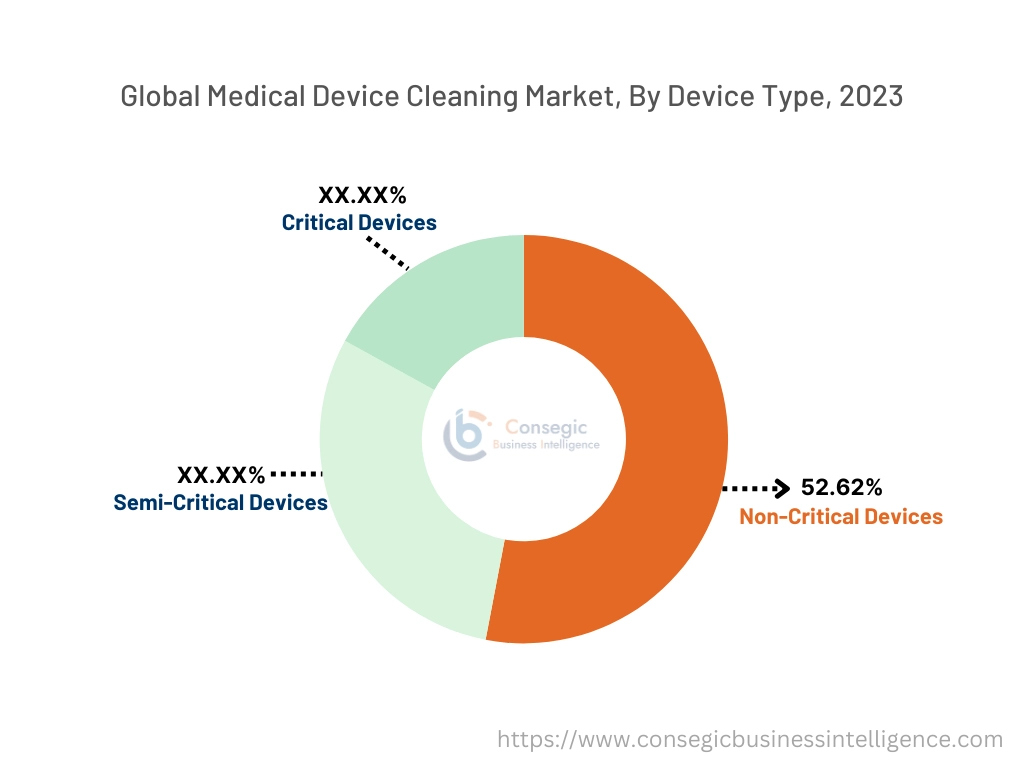
By End-User:
Based on components, the market is segmented into Hospitals and Clinics, Diagnostic Centers, Dental Hospitals and Clinics, and Other End Users.
Hospitals and Clinics segment accounted for the largest revenue share of the global Medical device cleaning market in 2023.
- Hospitals and clinics dominate as the largest end-user segment due to the extensive use of diverse medical devices across patient care settings.
- Growing regulatory mandates for stringent infection control and the increasing volume of surgical procedures are driving the demand for robust cleaning and disinfection solutions.
- The emphasis on Central Sterile Supply Departments (CSSD) within hospitals, which manage the cleaning, disinfection, and sterilization of medical instruments, further boosts the medical device cleaning market growth.
- These departments are integral to ensuring compliance with infection control standards, maintaining patient safety, and supporting the high turnover of reusable medical devices essential for daily clinical operations.
The Diagnostic Centers segment is anticipated to register the fastest CAGR during the forecast period.
- Diagnostic centers utilize devices like ultrasound probes and endoscopes, which demand stringent cleaning protocols to ensure patient safety and prevent cross-contamination.
- These semi-critical and critical devices frequently contact mucous membranes, necessitating high-level disinfection or sterilization.
- The growing number of diagnostic procedures, driven by early disease detection efforts, has increased the use of such devices, amplifying the need for effective cleaning solutions.
- Additionally, the adoption of advanced imaging technologies with complex designs has led centers to implement automated cleaning systems and specialized disinfectants, ensuring thorough decontamination while maintaining the integrity and functionality of these delicate instruments.
Regional Analysis:
The regional segment includes North America, Europe, Asia Pacific, the Middle East and Africa, and Latin America.
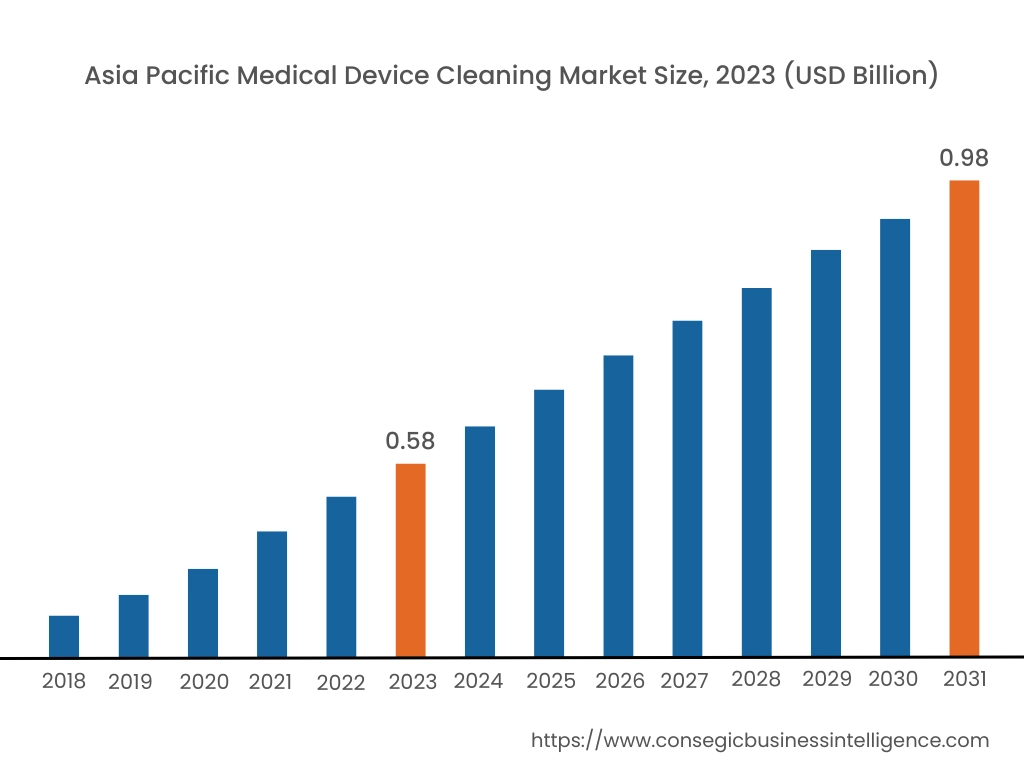
Asia Pacific region was valued at USD 0.58 Billion in 2023. Moreover, it is projected to grow by USD 0.61 Billion in 2024 and reach over USD 0.98 Billion by 2031. Out of these, China accounted for the largest share of 32.6% in 2023. The Asia-Pacific market is witnessing rapid growth due to the expanding healthcare infrastructure and rising awareness about patient safety. Government initiatives to reduce healthcare-associated infections (HAIs) in countries like China and India further drive demand.
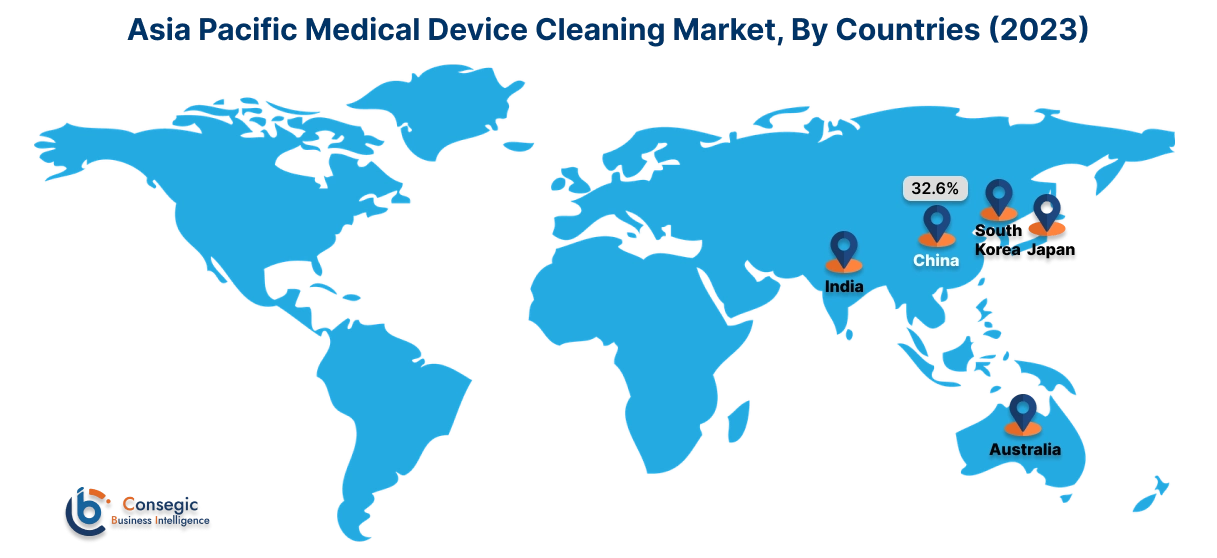
North America is estimated to reach over USD 1.78 Billion by 2031 from a value of USD 1.08 Billion in 2023 and is projected to grow by USD 1.13 Billion in 2024. The market in North America is driven by stringent healthcare regulations emphasizing infection control and high adoption rates of advanced cleaning technologies. Increasing surgical procedures and the presence of key industry players in the U.S. also support the medical device cleaning market industry.
Europe's market is influenced by strict regulatory standards for medical device sterilization and increasing investments in healthcare infrastructure. The presence of well-established healthcare systems and a growing focus on reducing HAIs contribute to market growth. As per the regional analysis, medical device cleaning market growth is supported by the increasing number of hospitals and clinics adopting infection control measures. However, limited access to advanced cleaning technologies in some countries may hinder market development.
The Latin American market is expanding due to rising healthcare expenditure and the increasing number of medical procedures. Growing investments in healthcare facilities, particularly in Brazil and Mexico, are propelling medical device cleaning market demand for effective medical device cleaning solutions.
Top Key Players & Market Share Insights:
The Medical device cleaning market is highly competitive with major players providing products in the national and international markets. Key players are adopting several strategies in research and development (R&D), product innovation, and end-use launches to hold a strong position in the global Medical device cleaning market. Key players in the medical device cleaning industry include
- STERIS plc (United States)
- 3M Company (United States)
- Getinge AB (Sweden)
- Ecolab Inc. (United States)
- Cantel Medical Corp. (United States)
- Advanced Sterilization Products (ASP) (United States)
- Metrex Research, LLC (United States)
- Ruhof Corporation (United States)
- Belimed AG (Switzerland)
- Sklar Surgical Instruments (United States)
Medical Device Cleaning Market Report Insights :
| Report Attributes | Report Details |
| Study Timeline | 2018-2031 |
| Market Size in 2031 | USD 4.21 Billion |
| CAGR (2024-2031) | 6.3% |
| By Process |
|
| By Application |
|
| By Device Type |
|
| By End-user |
|
| By Region |
|
| Key Players |
|
| North America | U.S. Canada Mexico |
| Europe | U.K. Germany France Spain Italy Russia Benelux Rest of Europe |
| APAC | China South Korea Japan India Australia ASEAN Rest of Asia-Pacific |
| Middle East and Africa | GCC Turkey South Africa Rest of MEA |
| LATAM | Brazil Argentina Chile Rest of LATAM |
| Report Coverage |
|
Key Questions Answered in the Report
What is the primary method for cleaning medical devices? +
Automated cleaning systems, such as washer-disinfectors and ultrasonic cleaners, are commonly used due to their high efficiency and ability to handle large volumes of instruments.
Why is cleaning verification important in medical device reprocessing? +
Cleaning verification ensures that residual proteins, which can interfere with sterilization, are effectively removed, reducing the risk of cross-contamination and infection.
What are the key trends in the medical device cleaning market? +
The key trends include the adoption of automated solutions, innovations in antimicrobial cleaning products, and a growing emphasis on hygiene protocols in outpatient and home healthcare environments.
How are ultrasonic cleaners different from traditional cleaning methods? +
Ultrasonic cleaners use high-frequency sound waves to clean complex devices, making them more effective in reaching intricate surfaces compared to manual scrubbing, thus reducing the risk of damage.
What role do antimicrobial wipes play in medical device cleaning? +
Antimicrobial wipes are gaining popularity for cleaning non-critical devices due to their convenience, effectiveness, and ability to disinfect surfaces quickly, supporting compliance with hygiene standards.
